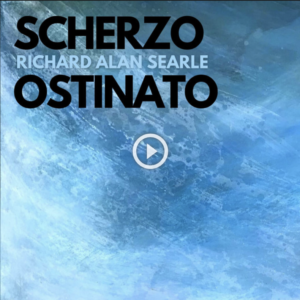Scherzo Ostinato (2020)
EP
duration: approx. 11 minutes
- Scherzo
- Ostinato I
Scherzo was originally a piano solo, characterised by use of the extremes of the instrument’s range. For this version, I separated the strands so that the scherzo theme is played perfectly robotically by software synthesisers, in contrast the flawed, human interpolations of the piano.
I initially recorded Ostinato I (there’s also an Ostinato II in a drawer somewhere) playing the ostinato figure on a “virtual” instrument, triggering the sampled notes of a Kalimba via a MIDI keyboard. I then replaced this with a real Kalimba, taking care to replicate the mistake in my original performance which, when looped, periodically slides the ostinato out of sync with the rest of the track.
Many thanks to Anna FitzGerald for granting her permission to use a detail from her painting Pollen Hunters in the cover artwork.
Red House Bagatelle (2020)
for solo piano
Duration: approx. 3 minutes
The Red House is part of a former school on the Dartington Hall Estate in Devon, where I’d stayed on a visit to the Dartington International Summer School. I’d taken the idea for this piece with me, planning to work on it during my stay. As usual, Dartington had many musical distractions, and the piece remained unfinished – although it did gain its title. Red House Bagatelle is dedicated to Francesca Hurst, whose call for pieces for her Daily Dose of Piano series gave me the impetus to complete it.
Fanfare (2020)
for jazz ensemble
Duration: approx. 7 minutes
Programme note coming soon
Variation After Variation (2020)
for solo violin
Duration: approx. 7 minutes
- Variation (after Paganini)
- Moto perpetuo I
- Procession I
- High variation
- Melody I
- Moto perpetuo II
- Dance
- Melody II
- Procession II
- Coda
In 2019 Fenella Humphreys put out an open call on Twitter for 16-bar variations on Paganini’s Caprice no. 24, and offered to tweet herself performing them. After Fenella included my response (and others) in a concert programme, I decided to expand the piece into its current form. My original variation is built on the elements of the very opening of Paganini’s Caprice: repeated notes in dotted rhythm, short scale fragments, and octave intervals. That variation is then itself subjected to a sequence of eight variations and a coda. As in Paganini’s original Caprice, the tempo remains constant throughout, and the music keeps returning to the home note of A.
Variation (After Paganini) (2019)
for solo violin
Duration: approx. 30 seconds
When Fenella Humphreys put out a call on Twitter for Paganini variations, this miniature was my response. I subsequently expanded it into Variation After Variation.
Fabulous stuff @richardalansear – it’s seriously fun to play! 👏👏👏 #PagVariations pic.twitter.com/5lL2cC4RdW
— Fenella Humphreys (@fhvln) August 29, 2019
The Witch Sycorax Addresses her Lover (1993)
for voice (B3 – Eb5) and piano
Duration: approx. 3 minutes
A setting of the poem of the same name by Vicki Raymond (from Selected Poems, Carcanet Press 1993)
My singing friend Ruth Holt had been asking, when are you going to write a song for me? I expect my answer would have been, when I find a suitable text. I’m not a habitual poetry reader, but Vicki Raymond’s Selected Poems was a volume I’d acquired, among others, to pore over in search of material. I found The Witch Sycorax Addresses her Lover appealing, and happily Vicki and her publisher were both keen for me to proceed. Ruth was less happy with my choice, and wondered if I thought of her as witch (I don’t). As far as I know, she’s never performed it in public. But we’re still friends.
Invocation and Dance (1992, revised 2020)
for oboe and piano
Duration: approx. 11 minutes
This is an early piece which I revised in 2020. In the opening Invocation, the oboe begins slowly and alone, with arabesques continually returning to the interval A-C#. The piano joins for a brief dialogue, ending with a long sustained chord underpinning the oboe’s closing statement. The Dance picks up the material of the Invocation, transforming it in various ways: sometimes in short agitated motifs, sometimes melodic and waltz-like, ultimately coming to a more restful conclusion.
Here’s a video demo of a short excerpt – the opening of the “Dance” – made using NotePerformer software.
